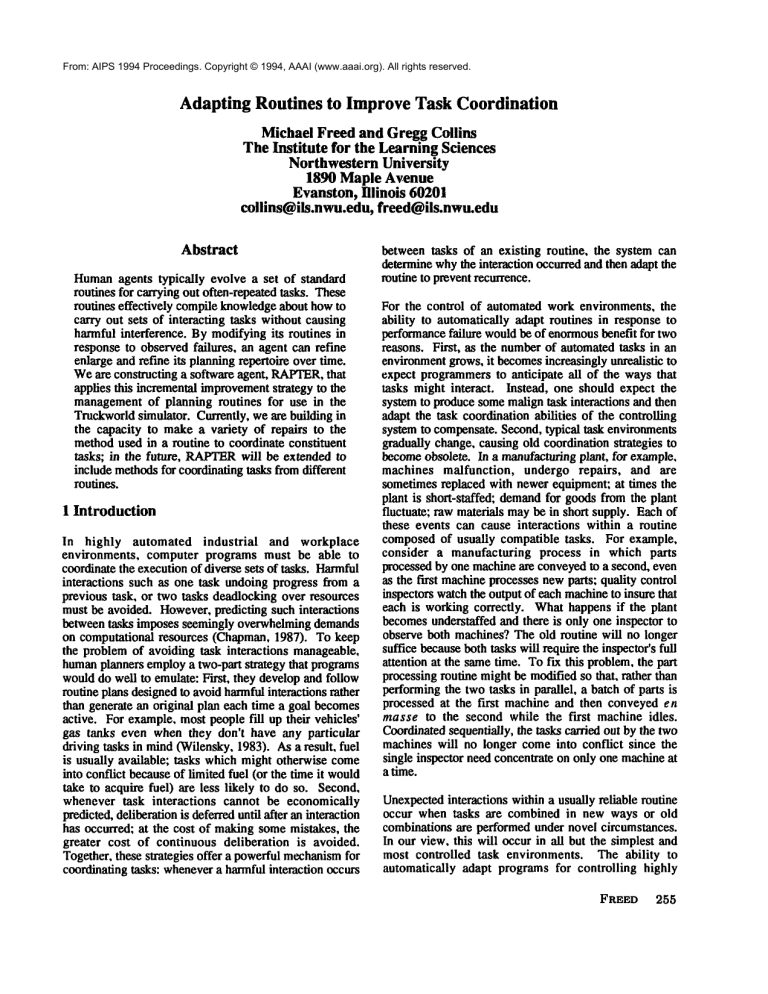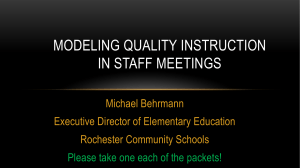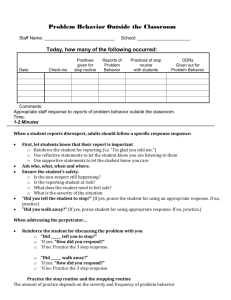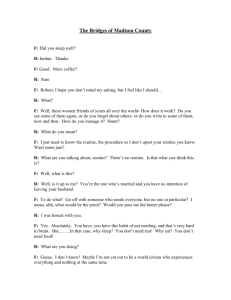
From: AIPS 1994 Proceedings. Copyright © 1994, AAAI (www.aaai.org). All rights reserved.
Adapting Routines to Improve Task Coordination
Michael Freed and Gregg Collins
TheInstitute for the LearningSciences
Northwestern University
1890 Maple Avenue
Evanston,Illinois 60201
collins@ils.nwu.edu, freed@ils.nwu.edu
Abstract
Humanagents typically evolve a set of standard
routines for carrying out often-repeated tasks. These
routines effectively compile knowledgeabout howto
carry out sets of interacting tasks without causing
harmful interference. By modifying its routines in
response to observed failures, an agent can refine
enlarge and refine its planning repertoire over time.
Weare constructing a software agent, RAFTER,
that
applies this incremental improvementstrategy to the
managementof planning routines for use in the
Truckworldsimulator. Currently, we are building in
the capacity to make a variety of repairs to the
methodused in a routine to coordinate constituent
tasks; in the future, RAPTER
will be extended to
include methodsfor coordinating tasks from different
routines.
1 Introduction
In highly automated industrial
and workplace
environments, computer programs must be able to
coordinate the execution of diverse sets of tasks. Harmful
interactions such as one task undoing progress fxom a
previous task, or two tasks deadlocking over resources
must be avoided. However, predicting such interactions
between tasks imposes seemingly overwhelming demands
on computational resources (Chapman, 1987). To keep
the problem of avoiding task interactions manageable,
humanplanners employa two-part strategy that programs
would do well to emulate: First, they develop and follow
routine plans designed to avoid harmful interactions rather
than generate an original plan each time a goal becomes
active. For example, most people fill up their vehicles’
gas tanks even when they don’t have any particular
driving tasks in mind(Wilensky, 1983). As a result, fuel
is usually available; tasks which might otherwise come
into conflict becauseof limited fuel (or the time it would
take to acquire fuel) are less likely to do so. Second,
whenever task interactions
cannot be economically
predicted, deliberation is deferred until after an interaction
has occurred: at the cost of making somemistakes, the
greater cost of continuous deliberation is avoided.
Together, these strategies offer a powerful mechanismfor
coordinating tasks: whenevera harmful interaction occurs
between tasks of an existing routine, the system can
determine whythe interaction occurred and then adapt the
routine to prevent recurrence.
For the control of automated work environments, the
ability to automatically adapt routines in response to
performancefailure wouldbe of enormousbenefit for two
reasons. First, as the numberof automated tasks in an
environmentgrows, it becomesincreasingly unrealistic to
expect programmersto anticipate all of the ways that
tasks might interact. Instead, one should expect the
system to produce somemalign task interactions and then
adapt the task coordination abilities of the controlling
system to compensate. Second, typical task environments
gradually change, causing old coordination strategies to
becomeobsolete. In a manufacturing plant, for example,
machines malfunction,
undergo repairs,
and are
sometimes replaced with newer equipment: at times the
plant is short-staffed; demandfor goods from the plant
fluctuate; raw materials maybe in short supply. Each of
these events can cause interactions within a routine
composed of usually compatible tasks. For example,
consider a manufacturing process in which parts
processed by one machineare conveyedto a second, even
as the fhst machineprocesses newparts: quality control
inspectors watchthe output of each machineto insure that
each is working correctly. What happens if the plant
becomesunderstaffed and there is only one inspector to
observe both machines? The old routine will no longer
suffice becauseboth tasks will require the inspector’s full
attention at the same time. To fix this problem, the part
processing routine might be modified so that, rather than
performingthe two tasks in parallel, a batch of parts is
processed at the first machine and then conveyed en
masse to the second while the first machine idles.
Coordinatedsequentially, the tasks carried out by the two
machines will no longer come into conflict since the
single inspector need concentrate on only one machineat
a time.
Unexpectedinteractions within a usually reliable routine
occur when tasks are combined in new ways or old
combinations are performed under novel circumstances.
In our view, this will occur in all but the simplest and
most controlled task environments. The ability to
automatically adapt programs for controlling highly
FREED 255
From: AIPS
1994 Proceedings.
Copyright
© 1994,
AAAI (www.aaai.org).
reserved.
routines
since
automated
environments
is thus
a practical
problem forAll rights
machine learning. Our approach has focused on two
problems in particular.
First, we have developed a
general frameworkfor learning from failure in which the
learning procedure uses knowledgeof the system’s task
coordination and execution mechanismsto mason about
how these mechanisms might have caused a failure
(Birnbaum el al, 1990). Second. we have begun
represent the abslract p "lanning knowledgeagents need to
reason about in order to cope with undesirable task
interactions (Freed & Collins 1994. Freed &Collins 1993.
Freed et al 1992; see also Jones 1991 and Owens1991).
Such knowledge can be incrementally specified and
integrated into routine execution mechanisms as the
system learns what kinds of interactions it must be
prepared for.
Weare testing our approach to learning about task
coordination using the RAPtask-execution system (Firby,
1989) and Truckworld simulator (Firby, 1987). The
system has a number of important properties for our
purpose. First, it reflects the need for minimal
deliberation while executing a task by sharply limiting the
amount and kinds of inference allowed at that time.
Second, it .allows the system to assess its current
knowledgeand explicitly attempt to acquire more at any
time in the process of carrying out a task. This ability is
crucial for controlling task interactions since methodsfor
coordinating tasks will often depend on information that
only becomes available
during task execution.
Truckworld is a simulated environment in which a robot
delivery truck faces problems such as obtaining fuel,
navigating to destinations over possibly obstructed roads
and acquiring items needed for delivery. In a later
section, we analyze an examplein this domainin which
tasks of a delivery truck routine interact and thereby cause
a goal failure. Wethen consider how the RAPsystem
controlling the truck could be modified to avoid such
incidents in the future. In the section immediately
following, we discuss our approach to the problem of
learning to coordinatetasks in greater detail.
2 Learning
from Failure
Routines are, ideally,
reliable,
reusable and
computationally cheap to execute. Their success in the~
regards dependson the stability of certain features of the
task environment. For example, shoppers at the grocery
store can usually expect to get hometo unpack before
frozen items have a chance to thaw. Consequently, their
routines for shopping mayassume no more than a certain
amountof traffic on the drive home,that the weather will
not be excessively hot, the car won’t malfunction, etc.. If
a shopper executes his normal routine while any of these
conditions are not met, he maywind up unpacking melted
ice cream. Such failures are endemic to the use of
256
POSTB~S
most of the conditions thai the determine
whether the routine will work are simply assumedto hold
and not checked. At the cost of occasional failure,
assuming the validity
of a phm’s most reliable
preconditions saves an enormousamountof deliberation.
Several strategies exist fiJr minimizingthe fidlurcs of
routines due to faulty underlying assumptions. One
strategy involves enforcing stability in the task
environment (Hammond,1990). For example, keeping
one’s car in goodrepair increases one’s c ’hancesof arriving
at homefrom the grocery store in time. Anotherinvolves
the use of heuristics to signal the need for extra
deliberation (Pryor &Collins, 1992)--for example,
observing the traffic on the way to the grocery store in
order to determine whether delays can be expected on the
drive home.
The approach we emphasize is to adapt routines when
they fail. This approach is based on the paradigm of
failure-driven learning, in which the agent relies on the
observed failure of specific, monitored expectations to
signal an opportunity to learn (Sussman, 1975, Schank,
1982, Hammond,1989, Birnbaum ct al, 1990, Ram&
Cox, 1991). In particular, whenan agent expects a routine
p’lan to achieve its goal, and this expectationis violated,
one response is to attempt to determinewhat aspect of the
routine’s representation was responsible for the faulty
behavior, and howthat aspect can be modified to avoid
the recurrenceof such failures.
To carry out this diagnostic process automatically, a
system must be able to reason about the assumptions
underlyingits failed expectation. In particular, it mustbe
able to retrieve (or generate) potentially faulty
assumptions in response to an observed expectation
failure. In our model, the connections betweenunderlying
beliefs and consequent expectations are represented in
terms of explicit justification structures (deKleer, 1987,
Simmons,1988, Birnbaumet at, 1990). Diagnosis, then,
consists of searching through the assumptions organized
by ,an expectation’s justification structure in order to
determine where the fault lies. A central goal of our
research is to learn how to construct justification
structures to enable the diagnosis of a wide variety of
failures. In particular, we are studying what kinds of
assmnptions must be organized and represented in an
expectation’sjustification.
2.1 Levels of compatibility
Whenan agent constructs a routine, it must make some
assumptions about the degree of compatibility between
tasks in the routine. Whenthe routine is executed in
unusual circumstances, such assumptions may fail,
possibly causing the failure of the wholeroutine. For the
purposes of adapting a routine to better coordinate such
From: AIPS 1994 Proceedings. Copyright © 1994, AAAI (www.aaai.org). All rights reserved.
tasks, it is thus important to represent the assumeddegree
of compatibility between tasks in a routine, so that
diagnostic processes can identify compatibility
assumptionsthat fail. The routine can then be modifiedto
coordinate interacting tasks based on an assumption of
reduced compatibility. In our model, there are five
qualitatively distinct levels of compatibility betweenpairs
of tasks, each of which suggests a different process for
coordination:
¯
¯
¯
¯
¯
Mutually exclusive
Order sensitive
Order insensitive
Specification sensitive
Specification insensitive
Mutually exclusive tasks are those for which executing
one task precludes ever successfully executing the other.
For example, if one’s house is burning down, one might
have umeto save the jewelry in the bedroomor the photo
albumsin the den, but not both. In general, this degree of
incompatibility arises only whentasks have incompatible
deadlines or when they use up some resource that is
unlikely to be recovered such as a large inheritance or a
favor owed by a powerful person. To coordinate such
tasks, a routine should include a step for selecting
betweenalternatives.
Order sensitive tasks can be executed successfully in one
order but not in others. In general, this occurswhenone
task is likely to violate a pre-conditionor post-condition
of another. Coordinating such tasks meansselecting
executionorder. Orderinsensitive tasks mustbe executed
at different times, but are otherwise fully compatible. For
example, one can only tie the shoelaces on one shoe at a
time but the order doesn’t typically matter. A pair of order
insensitive tasks each require access to some common
resource for which resource recovery is not an issue, such
as a wrench or one’s hands. Coordinating order
insensitive tasks involves only preventing concurrent
execution.
Specification sensitive tasks can be executed concurrently
as long as one properly chooses the methodof execution
for one or both tasks. For example, one may be
transporting armfuls of groceries while also trying to
unlock a door. While one’s usual procedure for unlocking
the door mayinvolve visually locating the keyhole, bags
of groceries obstructing one’s vision may require
unlocking the door using only tactile feedback.
Coordinatingspecification sensitive tasks entails selecting
methodsfor carrying out a task or other task parameters
so as to eliminate incompatible resource requirements.
Specification insensitive tasks, such as chewinggumand
walking, can be executed concurrently
explicit coordination.1
without any
3 Example
As we have discussed, insuring that a pair of tasks do not
interact involves coordinating their execution using
methodsappropriate to their actual level of compatibility.
Whena routine relies on overly optimistic assumptions
about the compatibility of its componenttasks, failures
are likely to result. Weare developing our approach to
learning from such failures using the RAPtask-execution
system (Firby, 1989). RAPsare representations of routine
behaviors containing a set of tasks and information on
how the tasks should be coordinated. 2 We are
3 that will diagnose
constructing a system called RAPTER
the cause of a RAPexecution failure and appropriately
modify the faulty RAP.Below, we present an example
from the Trnckworld domain in which a RAPexecution
failure occurs; we then discuss howthe faulty RAPcould
be identified and then modified to prevent recurrence of
similar failures.
3.1 Scenario: arriving late at the gas station
Before setting out on a long journey, the delivery truck
always checks its oil, inspects its manipulator arms and
refuels. Since, in most cases, it does not matter in what
order these tasks are executed, the RAPthat encodes the
journey preparation procedure does not impose any order
(see figure 1). Onone particular day, the truck readies
itself for a journey, arbitrarily deciding to run the refuel
task last. First, it checks the oil, which takes a few
seconds. Then it inspects each arm, taking over an hour
to disassemble and visually inspect various arm
components.Finally the truck leaves for the gas station
and arrives to find that the station has been closed for
twenty minutes.
1Another way to coordinate tasks is to interleave them.
This requires a relatively detailed analysis of the
compatilSility betweenthe ~sks; in particula-r, one must
consider the degree of compatibility~betweenconstituent
subtasks. For e-xample, on-e can successfully interleave
execution of a reading task with a train riding task by
assuming that the subtasks read-one-page and noticewhen-train-stops
may be executed-concurrently
(specification-ins-ensitive) but that check-station-sign-out’windowmust take precedence over read-one-page(order
sensitive) whenit becomesactive.
2Currently three levels of coordination betweenpairs of
tasks arepossible, corresponding to assumptlons of
mutual-exclusivity,
order-sensitivity
and orderinsensitivity; by default, each pair of tasks is orderinsensitive. A newer version of the system allowing task
concurrencyis under development(firby, 1993).
3short for l~APAdapter.
FREED 257
From: AIPS 1994 Proceedings. Copyright © 1994, AAAI (www.aaai.org). All rights reserved.
(DEFINE-RAP
(INDEX
(prep-journey))
(METHOD
rnethod-I
(TAS K-NET
(tl (edd-oil-if-ne~_
_e_~))
02 (inspecl-arms))
(t3(rduel-if-needed
15)))))
Figure1: RAPfor preparingto go on a longjourney
3.2 Learningfrom the example
Whatshould be donein responsem this failure? If the
cin:umstances
of the failure could neverbe repeated--for
example,if the ma:kwouldneveragainneedto refuel---it
wouldmakesenseto simply recover from thefailure
and
not expend any effort to leach. In the examplescenario
however,the failure arose from the execution of a routine,
and therefore often repeated,behavior.Failure to learn in
this casewouldsubject thesystem to potentially frequent
repetitions of the failure. In jzeneral, thehigh degree
of
reuse of memory struqtures
underlying a routine
behavior--RAPsin our case--suggeststhat adaptation in
response
to failure is crucial.
circumstancesrequired executing the refueling task t~rst.
One way to prevent a recurrence of the failure is to
modify the journey preparadon RAPso that wheneverthe
umeneededto navel to the gas station plus one hour (to
inspect the arms) wouldbring the truck to the gas station
after
closing,
the refuel task
will
beexecuted
f’n’st.
To discover this fix for itself, the learning system must
analyze the assumpuonsunderlying the routines current
sum:tttre. These assumptions can be ~ted in terms
of a justification su’ucture supportingthe belief that the
refueling task shouldsucceed (figure 2 showspart of this
smacnn’c).In our example,whenthe refueling task fails,
assump~onsimmediately underlying the expectation that
the gas station wouldbe openare examined.Oneof the
supporting assumptions--thatthe umck’s refuel attempt
would not occur during the station’s normal closing
hours---proves faulty. The system then attempts to
explain the failure of this assumption in terms of its
immediate supporters. The process continues to follow
the path of faulty assumptions through the justification
surucUncuntil a basis for repairing the system’s behavior
can be found. Diagnosis consists of finding a faulty
assumption.
To repair the failure, the agent’s routine must
be modified to no longer depend on the assumption.
Thus, the diagnosis process ends when a faulty
assumption
on which
to basea repair
hasbeenlocated.
3.3 TransformationRules
After locating a faulty assumptionthat caused a failure,
and determining how the system should behave in the
future to prevent the failure from recurring, the learning
process must incorporate the proposed new behavior into
the system by modifying appropriate task execution
components--RAPs in our case. Knowledge about how
to incorporate behavioral changes can be embodied in
transformation rules (Hammond,1989, Collins, I989).
The left hand side of a transformation rule indicates when
the rule should be applied. A transformation rule’s right
hand side specifies a procedure for modifying a given
RAPthat will produce the designated adaptation. In
effect, each transformationrule encodesa standard fix for
a particular class of plan failures. The output of the
diagnosis process is used to determine the class into
whichthe current failure falls.
Figure
2: JustLficafion
slzucture
in gasstationexample
Intheexample
scenario,
then’uck
failed
toarrive
intime
atthegasstation
because
itsroutine
forpreparing
fora
longjourney
failedto properly
coordinate
twoof its
componenttasks.In particular,
it reliedon the
assumptionthat refuelingand performingan arm
inspection
were order-insensitive
when,in fact.
258
POSTERS
In the gas station example, the justification traversal
process faults aa assumption corresponding to the left
hand side of the transformation rule called addconditional-ordering-constraint:fixed-deadline.
The
effect of this rule is to cause two tasks in a RAPto be
executed in a particular order wheneverthe curtvnt time
exceeds somefixed deadline. 4 The rule is applied to the
4See (Freed and Collins, 1994) for an explanation of why
this rule is especially appropriate.
From: AIPS 1994 Proceedings. Copyright © 1994, AAAI (www.aaai.org). All rights reserved.
PREP-JOURNEY
RAP using modification parameters
specified during the justification
traversal process
(Birnbaumet at, 1990, Kruiwich, 1991).
As output, the transform produces a modified version of
the original PREP-JOURNEY
RAPcontaining an extra
method in which the specified tasks are ordered (see
Figure 3). Ordering constraints are denoted by for
statements following the task call in a method’s TASKNET. Applicability restrictions,
expressed inside a
CONTEXT
clause, are added to the old and new methods
to cause the appropriate one to be selected whenthe tasks
are considered for execution.
(DEFINE-RAP
(INDEX
(prep-journey)
(METHOD
method(CONTEXT
(and(current-time?time) (< ?time(pro 7 30))))
(TASK-NET
(tl (add-oil-if-needed))
(t2 (inspect-arms))
(t3 (refuel-if-needed15))))
(METHOD
method-2
(CONTEXT
(and (current-time?time) (>= ?time(pm7 30))))
TAS K-NET
(tl (add-oil-if-needed))
(t2 (inspeet-arms))
(L3(refuel-if-needed15) (for t2)))))
Figure 3: PREP-JOURNEY
after applying add-conditionalordering-constraint:fixed-deadline
4 Conclusion
In order to avoid harmful plan interactions, humanagents
typically evolve a set of standard routines for carrying out
often-repeated tasks. By modifying these routines in
response to observed failures, the agent can refine its
behavior over time. Weare constructing a software agent,
RAPTER,that applies this incremental improvement
sWategyto the management
of planning routines for use in
the Truekworldsimulator. Currently, we are building in
the capacity to makea variety of repairs to the method
used in a routine to coordinate constituent tasks; in the
future, RAPTER
will be extended to include methods for
coordinating tasks from different routines.
References
Agre, Philip (1988). TheDynamicStructure of EverydayLife.
Ph.D. thesis. MITDepartmentof Electrical Engineeringand
ComputerScience.
Birnbaum.L., Collins, G.. Freed. M., and Krulwich,B. (1990).
Model-based
diagnosis of planningfailures. In Proceedingsof
the EighthNationalConference
on Artificial Intelligence. pages
318---323, Boston.MA,1990.
Chapman,
D. (1987) Planningfor conjunctivegoals. Artificial
lnteUigence,32(3):333--374,July 1987.
Collins, G. (1987) Plan Creation: Using Strategies as
Blueprints. Ph.D. thesis, Yale University, 1987. (Research
Report#599).
Collins, G. (1989)Planadaptation:Atransformationalapproach.
In K. Hammond,
editor, Proceedingsof the Workshopon CaseBasedReasoning,Palo Alto, 1989. DefenseAdvancedResearch
Projects Agency,MorganKaufmann,Inc.
deKleer,J. and Williams.B. (1987). Diagnosing
multiplefaults.
Artificial Intelligence,32(1):97--129,April1987.
Firby, R. (1993).Interfacing
the rap systemto real-timecontrol.
Technical
report.
(Available
via FTP at
cs.uchicago.edu:pub/users/firby/newraps.hqx)
Firby, R. and Hanks,S. (1987)Thesimulatormanual.Technical
Report YaleU/CSD/RR
Number563, Yale University, 1987.
Firby, R. (1989). Adaptive Execution in ComplexDynamic
Worlds.Ph.D.thesis, YaleUniversity.(Availableas ReportRR672).
Freed, M.and Collins, G. (1994). Learningto cope with task
interactions. Proceedingsof the 1994AAAI
Spring Syposium
on
Goal-drivenLearning.
Freed, M. and Collins, G. (1993). A model-basedapproach
learningfromattention-focussingfailures. In Proceedings
of the
Fifteenth AnnualConferenceof the CognitiveScience Society,
pages434--439,Boulder,CO.
Freed, M., Krulwich, B., Birnbaum, L. and Collins, G.
Reasoningabout performanceintentions. In Proceedingsof the
FourteenthAnnualConferenceof the CognitiveScienceSociety,
pages 242--247.Bloomington,IN.
Hammond
K. (1989). Case-based planning: Viewingplanning
as a memory
task. Academic
Press, San Diego,CA.
Jones, E. (1991) The flexible use of abstract knowledge
planning.Ph.D.thesis, YaleUniversity.
Krulwich,B. (1991). Determiningwhal to learn in a multicomponent
planningsystem. In Proceedingsof the 14th Annual
Conferenceof TheCognitiveScience Society, pages 102--107,
Chicago,IL.
Owens,C. (1991). A functional taxonomyof abstract plan
failures. Proceedingsof the 14th AnnualConferenceof The
CognitiveScienceSociety, pages167--172,Chicago,IL.
Pryor,L. andCollins, G. (1992).Referencefeatures as guides
reasoningaboutopportunities. In Proceedings
of the Fourteenth
Annual Conference of the Cognitive Science Society,
Bloomington,IN.
FREED 259
From: AIPS 1994 Proceedings. Copyright © 1994, AAAI (www.aaai.org). All rights reserved.
Ram. A. and Cox, M. (1991). Using introspective reasoning
select learning strategies.
In Proceedings of the First
International Workshopon Multistrategy Learning.
Schank, R. (1982). Dynamic Memory. Cambridge University
Press, Cambridge, England.
Simmons, R. (1988). Combining a.¢sociational and causal
reasoning to solve interpretation and planning problems. PhD
thesis, MITAI Lab.
Sussman, G. (1975). A ComputerModel of Skill Acquisition.
American Elsevier, NewYork.
Wilensky, R. (1983). Planning and Understanding:
A
Computational Approach to Human Reasoning. AddisonWesley Publishing Company,Reading, Ma.
260
POSTERS



